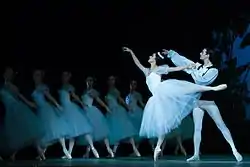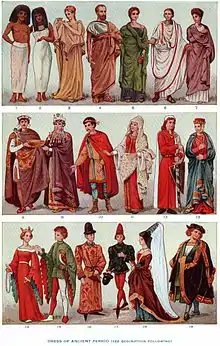Ballerina skirt
Ballerina skirt is a full skirt that reaches to mid-calf or just above the ankles, worn as a costume in a ballet performance. It is often made up of multiple layers of fabric.[1] It was a popular casual skirt style during the 1950s.
Ballerina skirts have been a consistently popular length for formal dresses, especially for young women. The most persistent image of a ballerina skirt is that worn by the most famous ballerina Anna Pavlova. Early ballerina skirts were heavy, bulky and unwieldy, severely restricting the dancer's movements. By the early twentieth century, skirts were raised to the knees to showcase pointe work.[2]
The Ballerina skirt is typically made up of five to 12 layers of tulle fabric. A ballerina skirt is designed to look feminine and elegant, as well as being associated with the traditional costume for classical ballet performances.
Different types of the ballerina skirts are used in ballet performance including the romantic, classic, pancake, balanchine and platter skirts.

History
From the early 1550, Roman dress had a strong influence on costume design: silk skirts were voluminous and key details were often exaggerated, that was usually based on everyday wear. During the seventeenth century, silks, satins and other fabrics were embroidered with real gold and precious stones that increased the level of decoration with ballet costumes, however, the heavy garments and supporting structures did not allow the dancers to perform graceful gestures.[3]
During the early 1700s the panier, a hooped petticoat was just invented that help raised the skirts a few inches off the ground. When the Romantic movement came about, ballet costumes were emphasized to be more tight fitting.[3] The romantic tutu came about in Paris in 1832 when Marie Taglioni premiered in the skirt in the ballet La Sylphide.[4] The skirt is a bell-shaped calf length style; it falls halfway between the knees and ankles and it was made of layers of stiffened tarlatan or starched, sheer cotton muslin that gave the illusion of fullness without being weighty. By 1870 other ballerinas began wearing tutus cut above the knee allowing to show complicated footwork with ruffled underpants attached to the skirt.[5]
Ballet skirts began to get shorter during the 20th century. Some ballet skirt had tarlatan layers which help create a flared-from-the body effect. In the 1940s wire hoops were inserted to enable the skirt to stand out from the hips. Tulle soon replace tarlatan making the hoop an option rather than being a necessity.[5] The most common style today is the short skirt which appeared in the late nineteenth century and it is made of different materials ranging from fluffy to thin fabrics.[4]
See also
References
- Valerie Cumming, C. W. Cunnington, P. E. Cunnington, The Dictionary of Fashion History, Berg, 2010, p 11
- "Encyclopedia of clothing and fashion". Encyclopedia of clothing and fashion RSS. Retrieved July 10, 2017.
- Hecht, Thomas. "Ballet Costume". Encyclopedia of Clothing and Fashion. 1: 114–116 – via Gale ebooks.
- Wulff, Helena. "Costume for Dance". Berg Encyclopedia of World Dress and Fashion: West Europe: 498–502 – via Berg Fashion Library.
- Looseleaf, Victoria. "The Story of the Tutu". Dance Magazine.
